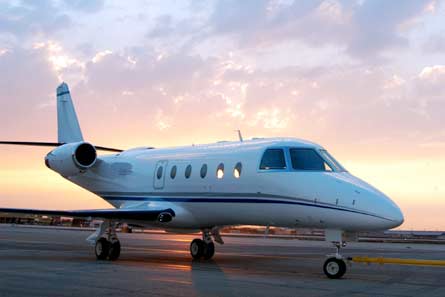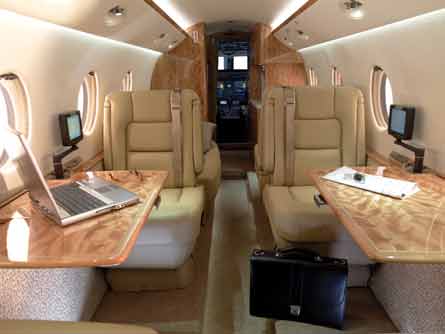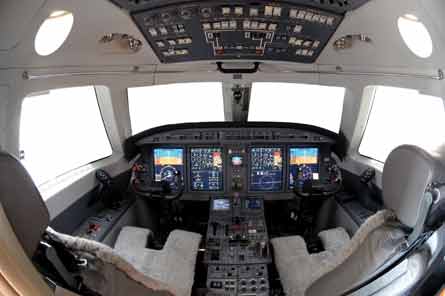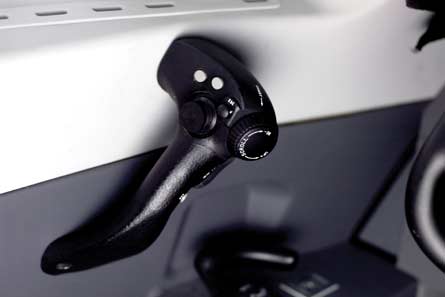Gulfstream’s mid-size G150 is entering service after a development programme that resulted in better than predicted performance. Is it now the one to beat?
For Gulfstream, entry into service of the first G150 business jet in August was almost as significant an event as the first flight of the Grumman Gulfstream I exactly 48 years earlier. The elegant, turboprop GI introduced the Gulfstream name to the fledging business aviation market, but the practical, affordable G150 provides a manufacturer best known for it high-end jets with a strong competitor in the higher volume middle of the market.
 |
|---|
Gulfstream is optimistic the G150 will take a substantial share of mid-size business jet sales |
“The industry would say this is our first real foray into building and outfitting a smaller aircraft, and it embodies everything that is a Gulfstream,” says chief operating officer Joe Lombardo. The US company believes the G150, developed jointly with designer and manufacturer Israel Aircraft Industries (IAI), offers the performance, cabin comfort and product support required to take a substantial share of mid-size business jet sales.
Gulfstream entered the mid-size market in 2001 when it acquired Galaxy Aerospace, later renaming the former IAI Astra SPX the G100. But despite its high performance, the rebranded aircraft remained a slow seller because its narrow cabin was unappealing compared with those of other mid-size jets, including Raytheon’s market-leading Hawker 800XP and Cessna’s new Citation Sovereign.
Swept wing
The Astra first flew in March 1984 and was a development of IAI’s Westwind 2 business jet, itself a derivative of the Aero Commander Jet Commander, the rights to which IAI had acquired in 1968. The Astra introduced a high-speed swept wing, repositioned to under the fuselage to provide more cabin space. The aircraft was produced from 1985 to 1989 then replaced by the Astra SP, which had an updated interior and glass cockpit.
The Astra SP was produced from 1990 to 1995 then followed by the improved SPX, which introduced winglets, digitally controlled Honeywell TFE731-40 turbofans and Rockwell Collins Pro Line 4 avionics, but did nothing to address the aircraft’s cramped cabin and dated appearance. In 2002, the Astra SPX became the Gulfstream G100, which remained in production at IAI’s Tel Aviv plant until 2005.
In all, over almost 20 years, a total of just 149 Astras and G100s were produced by IAI – while last year alone, Bombardier, Cessna and Raytheon delivered a combined 122 mid-size jets. Gulfstream had to do something to become competitive in the mid-size market, and its answer came in 2002 with the launch of the G150, a derivative of the G100 with a 300mm (12in) wider cabin, reprofiled nose, integrated flightdeck and other refinements.
 |
|---|
The cabin is roomier than the G100's and has G200-style cabin windows |
According to Pres Henne, Gulfstream senior vice-president programmes, engineering and test, the result is an aircraft that is both the fastest and the roomiest in its class, and which can take off fully loaded from a 1,525m (5,000ft) runway and fly almost 5,500km (3,000nm). “We expect the G150 to do well against the competition in this big [mid-size] market,” he says.
Already there are signs of success. Taking delivery of the first G150 in August for use as a company demonstrator, Gulfstream president Bryan Moss said the production backlog was “about a year”, with aircraft sold beyond that point. The company has a similar backlog on the super mid-size G200, which is also produced by IAI.
Although the manufacturer does not disclose production plans, Nick Chabraja, chairman and chief executive of parent company General Dynamics, has said Gulfstream will deliver 50 “mid-cabin” aircraft next year – split equally between the G150 and G200. That is double the number delivered in 2005, when IAI produced only four G100s.
Key to the G150’s cabin is a “lateral stretch” that increases width by 30mm, to 1.75m, and height by 50mm, also to 1.75mm. The result is a unique oval cross-section with relatively straight sidewalls that Gulfstream says provides more seated head and foot room than the competition. The cabin is 300mm wider at head level than either the Hawker or the Sovereign, and at foot level is 100mm and 400mm wider, respectively. Compared with the G100, the roomier cabin allows 50mm wider seats, a 100mm broader aisle and the addition of 50mm-wide arm ledges along the cabin walls. The G150 also has larger, G200-style cabin windows and LED interior lighting.
The wider fuselage drives many of the other G150 changes, including a broader cockpit for better accessibility and a reshaped nose for better aesthetics, aerodynamics and visibility. A 400mm plug aft of the wing tapers the wider fuselage into the existing G100 tail unit and houses a larger fuel tank and an external heated baggage bay with increased, 1.56m3 (55ft3) volume and 500kg (1,100lb) capacity. The supercritical wing is unchanged from the G100, but its attachment to the fuselage is moved outboard 150mm by the lateral stretch. A new wing/body fairing reduces drag.
The G100’s TFE731-40 engines are retained, but a “throttle push” change to the digital electronic engine control software increases thrust on take-off by 5%, to 4,420lb (19.7kN), and by 6-7% in the climb and 4% in the cruise. Engine bleed air is used for pressurisation, heating, air-conditioning and nacelle anti-icing, but Goodrich Estane pneumatic de-icing boots protect the leading edges of the wing and tailplane, their silver colour a better match for the polished leading edges of other Gulfstreams than traditional black rubber boots. The standard tail-mounted Honeywell RE100 auxiliary power unit is almost 14kg lighter than the G100’s, and can be operated up to 35,000ft.
Upgraded systems
Systems are largely taken from the G100, upgraded where necessary to improve reliability or replaced with better systems from the G200. Enhancements include G200-style digital nosewheel steering control through the tiller and rudder pedals. The 4,650kg-capacity fuel system is simplified, and the larger fuselage bladder means fuel extension tanks are no longer necessary while fuselage-to-wing transfer valves have been removed. Dried bleed air is used to pressurise one of two door seals, and a digital pressurisation controller from the G200 maintains cabin altitude.
Reliability of the electrically driven flaps and slats, a problem on the G100, has been improved by redesigning the systems to be more robust. More reliable pumps are used in the two 20.7bar (3,000lb/in2) hydraulic systems, which power the ailerons, spoilers, landing gear, thrust reversers, brakes and nosewheel steering. The G150 has eight speed brake/ground spoiler panels on the wing, compared with four on the G100, and they can deploy to 45°, compared with 20°. Elevator trim tab area has been increased to reduce rotation forces on take-off.
The biggest system change from the G100 is the Rockwell Collins Pro Line 21 integrated flightdeck, centered on four 12 x 10in liquid-crystal displays arranged two per side in portrait format. An engine indication and crew alerting system is standard, as are dual digital flight management systems (FMS) with integrated global positioning systems. A maintenance diagnostic computer is provided.
Although the PlaneView cockpit developed for its large-cabin business jets is based on Honeywell avionics, Gulfstream has incorporated several of its features in the G150’s Collins-based flightdeck. These include a full-span attitude director indicator (ADI), and G150-specific aircraft symbology on all displays and, along with colour, on electronic charts. Traffic alerts and terrain warnings pop up on the displays, and traffic collision avoidance system (TCAS) pitch guidance is presented on the ADI in the form of a red threat box and yellow fly-to box.
Cursor control
In August 2005, after the aircraft had been flying for three months, Gulfstream decided to add its signature sidearm cursor control devices (CCD) to the G150 cockpit. Mounted on the sidewall and resembling a fighter’s throttle grip, the CCD allows control of display menus and range, TCAS display selection, scrolling through cautions and alerts, and control of weather radar and enhanced ground proximity warning system, as well as push-to-talk. The CCD can be used to interface with the electronic charts, graphical weather, electronic checklist and three-dimensional FMS maps provided by Collins’ optional IFIS integrated flight information system.
The G150 is the first IAI-built business jet to be designed with Gulfstream input, and the Israeli company set aggressive goals for reduced development and production costs. The aircraft is also IAI’s first digital design, electronically defined and stored as three-dimensional solid models using the UGS computer-aided design system. Extensive use is made of high-speed machining to reduce cost and weight, and the forward and aft fuselage bulkheads are single-piece machined components, whereas in the G100 and G200 they are built up from sheet-metal detail parts. Most detail parts manufacture is outsourced, with IAI focusing on machined components and final assembly. Denel Aviation in South Africa produces the tail section and Sonaca NMF Canada provides the wing skins.
 |
|---|
 |
The broader cockpit gives better accessibility: Gulfstream's signature sidearm cursor control device was added in August 2005 |
US firm Electroimpact was selected to design and build the join cell, where the forward, centre and aft fuselage and wings are mated at IAI. While larger companies use automatic laser alignment systems costing hundreds of thousands of dollars, IAI wanted a simple, open join cell suited to the assembly of a mid-size jet that sells for $13 million. Mating begins with the centre fuselage mounted on four fixed posts via the wing carry-through structure. The other four assemblies are mounted on movable tooling and manoeuvred into place with hand-cranked screw actuators. Although manually operated, the cell provides electronic verification and recording of join positions.
The G150 first flew from Tel Aviv in May 2005, beginning an aggressive two-aircraft flight test programme that led to Israeli and US certification in November that year, 10 weeks ahead of schedule. Approval was for the green aircraft, as an amendment to the Astra/G100 type certificate. The second aircraft was then flown to Gulfstream’s completion centre at Dallas Love Field in Texas for installation and supplemental type certification of the interior and other equipment, including the CCDs.
Gulfstream’s Dallas centre is already responsible for outfitting G200s, their completion having been transferred from the former Galaxy Aerospace facility at Alliance airport in Fort Worth. There are three cabin layouts available for the G150 seating six, seven or eight passengers, and the centre builds its own cabinetry and seats, rather than outsourcing, to keep a better control of costs, quality and supply. By the end of September, four G150s had entered service, and another six were in work at Dallas.
While the major change from the G100 the G150 to make the entry-level Gulfstream competitive in the mid-size market is its cabin, what may give the aircraft an edge is its performance. During flight testing, range was increased by 460km, take-off balanced field length reduced by 253m and landing distance shortened by 158m over original projections. The range increase resulted from a drag reduction programme that included reshaping the engine pylons and sealing aileron, elevator and flap gaps.
Range and speed
As a result, the G150 has a range of 5,460km at Mach 0.75 and 4,810km at M0.8. Maximum operating speed is M0.85 and maximum cruise altitude 45,000ft. Take-off balanced field length is now 1,525m, a 14% improvement, and landing distance 878m, a reduction of 16%. All this combined gives Gulfstream the confidence to claim that the G150 “has the best overall performance of any mid-size business jet”.
“The G150 will be able to fly non-stop from New York to Los Angeles against any headwind,” says Henne. The manufacturer calculates the G150, flying at M0.8 against a 63kt (117km/h) headwind, will be make the trip 22min quicker than a Citation Sovereign at M0.75 and 55min quicker than the latest Hawker 850XP at M0.7.
Such claims will be put to the test as more G150s enter service domestically, as well as internationally – where Moss suspects there is a potentially large untapped demand for a mid-size aircraft in markets like China, India and Russia. “We don’t have much credible research data on the international market, but with 3,000nm range this aircraft should have strong appeal outside our traditional markets, and it is very affordable.”
Source: Flight International























